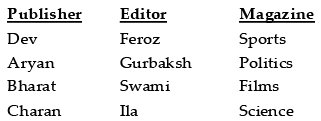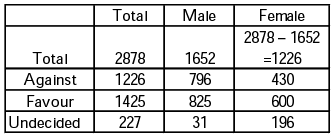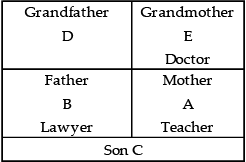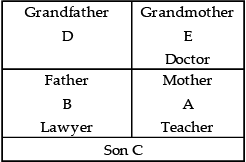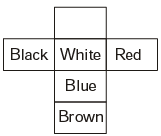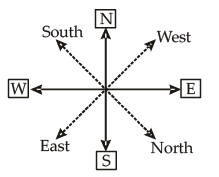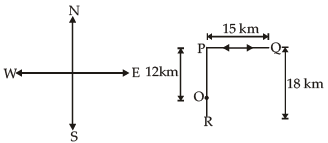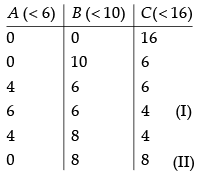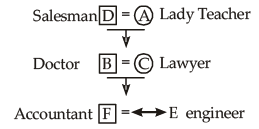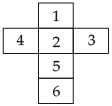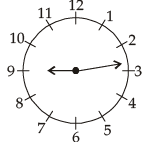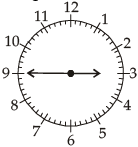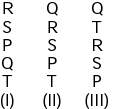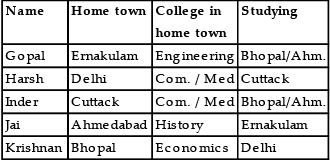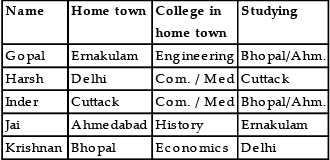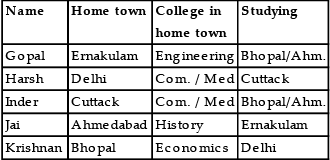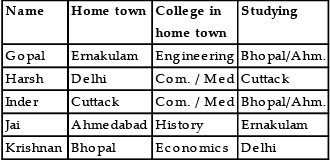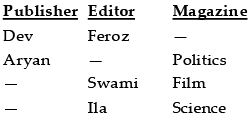Mental Ability, Analytical & Logical Reasoning- Solved Questions(1995-2020)- 7 - UPSC PDF Download
Question 1: DIRECTIONS: Read the following passage and answer the 3 (three) items that follow :
In a survey regarding a proposed measure to be introduced, 2878 persons took part of which 1652 were males. 1226 persons voted against the proposal of which 796 were males. 1425 persons voted for the proposal. 196 females were undecided.
How many females were not in favour of the proposal? [2011 - II]
(a) 430
(b) 496
(c) 586
(d) 1226
Correct Answer is Option (a).
Now, number of female voted against= 1226 –796 = 430
Now, number of female voted for the proposal = 1226 – (430 + 196) = 1226 – 626 = 600
No. of undecided = 2878 – (1226 + 1425) = 227
Now, No. of undecided male = 227 – 196 = 31
Question 2: DIRECTIONS : Read the following passage and answer the 3 (three) items that follow :
A, B, C, D and E are members of the same family. There are two fathers, two sons, two wives, three males and two females. The teacher was the wife of a lawyer who was the son of a doctor. E is not a male, neither also a wife of a professional. C is the youngest person in the family and D is the eldest. B is a male.
How is D related to E ? [2011 - II]
(a) Husband
(b) Son
(c) Father
(d) Wife
Correct Answer is Option (a).
The given information can be tabulated as follows:
Question 3: DIRECTIONS : Read the following passage and answer the 3 (three) items that follow :
A, B, C, D and E are members of the same family. There are two fathers, two sons, two wives, three males and two females. The teacher was the wife of a lawyer who was the son of a doctor. E is not a male, neither also a wife of a professional. C is the youngest person in the family and D is the eldest. B is a male.
Who are the females in the group ? [2011 - II]
(a) C and E
(b) C and D
(c) E and A
(d) D and E
Correct Answer is Option (c).
The given information can be tabulated as follows:
Question 4: DIRECTIONS : Read the following passage and answer the 3 (three) items that follow :
A, B, C, D and E are members of the same family. There are two fathers, two sons, two wives, three males and two females. The teacher was the wife of a lawyer who was the son of a doctor. E is not a male, neither also a wife of a professional. C is the youngest person in the family and D is the eldest. B is a male.
Whose wife is the teacher? [2011 - II]
(a) C
(b) D
(c) A
(d) B
Correct Answer is Option (d).
The given information can be tabulated as follows:
Question 5: A cuboid has six sides of different colours. The red side is opposite to black. The blue side is adjacent to white. The brown side is adjacent to blue. The red side is face down. Which one of the following would be the opposite to brown? [2010]
(a) Red
(b) Black
(c) White
(d) Blue
Correct Answer is Option (c).
Here, figure is drawn on the basis of the given conditions. White and brown are on the opposite faces.
Question 6: In a meeting, the map of a village was placed in such a manner that south-east becomes north, north-east becomes west and so on. What will south become? [2010]
(a) North
(b) North-east
(c) North-west
(d) West
Correct Answer is Option (b).
From the figure, it is clear that ‘S’ becomes ‘North-east’ in the new figure (dotted line).
Question 7: P, Q, R and S are four men. P is the oldest but not the poorest. R is the richest but not the oldest. Q is older than S but not than P or R. P is richer than Q but not than S. The four men can be ordered (descending) in respect of age and richness, respectively, as [2010]
(a) PQRS, RPSQ
(b) PRQS, RSPQ
(c) PRQS, RSQP
(d) PRSQ, RSPQ
Correct Answer is Option (b).
Q > S, P > Q, R > Q
Age: As, Q > S, P > Q, R > Q
Also, P is the oldest.
∴ P > R > Q > S
Richness : As, P > Q, S > P
Also R is he richest.
∴ R > S > P > Q
Question 8: Six persons M, N, O, P, Q and R are sitting in two rows, three in each. Q is not at the end of any row. P is second to the right of R. O is the neighbour of Q and is sitting diagonally opposite to P. N is the neighbour of R. On the basis of above information, who is facing N? [2010]
(a) R
(b) Q
(c) P
(d) M
Correct Answer is Option (b).
As P is 2nd to the right of R and there are three persons in each row, so clearly P and R at the extreme ends. As N is the neighbour of R, so it must come in the middle of P and R → P N R.
As O is diagonally opposite to P and neighbour of Q, so the final arrangement
P N R
M Q O
Thus, Q is facing N.
Question 9: Six books A, B, C, D, E and F are placed side by side. B, C and E have blue cover and the other books have red cover. Only D and F are new books and the rest are old. A, C and D are law reports and others are Gazetteers. Which book is a new law report with a red colour? [2010]
(a) A
(b) B
(c) C
(d) D
Correct Answer is Option (d).
From above, clearly D is the new law report with a red colour.
Question 10: A person travels 12 km due North, then 15 km due East, after that 15 km due West and then 18 km due South. How far is he from the starting point? [2009]
(a) 6 km
(b) 12 km
(c) 33 km
(d) 60 km
Correct Answer is Option (a).
let O be the starting point and P, Q and R the positions after every movement. Hence, Distance from the starting point = Distance of final position R from O = OR = 18 – 12 = 6 km.
Question 11: There are three cans A, B and C. The capacities of A, B and C are 6 litres, 10 litres and 16 litres respectively. The can C contains 16 litres of milk. The milk has to be divided in them using these three cans only.
Consider the following statements:
- It is possible to have 6 litres of milk each in can A and can B.
- It is possible to have 8 litres of milk each in can B and can C.
Which of the statements given above is/are correct? [2009]
(a) 1 only
(b) 2 only
(c) Both 1 and 2
(d) Neither 1 nor 2
Correct Answer is Option (c).
In the starting C has 16 litres of milk. Now, following transformations can be made.
Here, it should be kept in mind that volume of A, B and C should never exceed 6, 10 and 16 l , i.e. their capacities respectively.
Equation (I) satisfies statement 1 and equation (II) satisfies statement 2.
Question 12: There is a family of 6 persons A, B, C, D, E and F. There are two married couples in the family. The family members are lawyer, teacher, salesman, engineer, accountant and doctor.
D, the salesman is married to the lady teacher. The doctor is married to the lawyer. F, the accountant is the son of B and brother of E. C, the lawyer is the daughter-in-law of A. E is the unmarried engineer. A is the grandmother of F. How is E related to F? [2009]
(a) Brother
(b) Sister
(c) Father
(d) Cannot be established (cannot be determined)
Correct Answer is Option (d).
As, sex of E is not clear, so E can be brother or sister of F. Hence, relation between E and F can’t be established
Question 13: How many letters of the English alphabet (capitals) appear same when looked at in a mirror? [2009]
(a) 9
(b) 10
(c) 11
(d) 12
Correct Answer is Option (c).
These are 11 such letters.
A, H, I, M, O, T, U, V, W, X and Y
Question 14: Six persons A, B, C, D, E and F are standing in a row. C and D are standing close to each other alongside E. B is standing beside A only. A is fourth from F. Who are standing on the extremes? [2009]
(a) A and F
(b) B and D
(c) B and F
(d) None of the above
Correct Answer is Option (c).
C, D, E are together.
Also, A and B are together.
Possible arrangements,
Now, since A is fourth from F,
F must lie on the extreme end.
Thus, B and F are on the extreme positions.
BACDEF or FCDEAB
Question 15: How many different triangles are there in the figure shown below? [2008]
(a) 28
(b) 24
(c) 20
(d) 16
Correct Answer is Option (a).
Total number of triangles in the three square boxes = 24.
Number of triangles formed in two adjacent square boxes = 4.
Hence, total number triangles = 24 + 4 = 28
Question 16: Six faces of a cube are numbered from 1 to 6, each face carrying one different number. Further,
1. The face 2 is opposite to the face 6.
2. The face 1 is opposite to the face 5.
3. The face 3 is between the face 1 and the face 5
4. The face 4 is adjacent to the face 2.
Which one of the following is correct? [2007]
(a) The face 2 is adjacent to the face 3
(b) The face 6 is between the face 2 and the face 4
(c) The face 1 is between the face 5 and the face 6
(d) None of the above
Correct Answer is Option (a).
As it is clear from the figure that face 2 is adjacent to face 3.
Question 17:
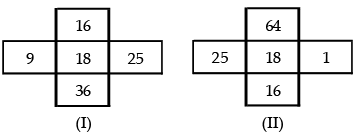
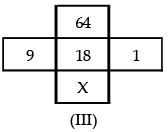
What is the value of X in figure III? [2006]
(a) 4
(b) 16
(c) 25
(d) 36
Correct Answer is Option (d).
In every figure the sum of square route of all corner digits comes in middle box. Here, underoot of 9 = 3
Underoot of 64 = 8, underoot of 1 = 1
Now, 3 + 8 + 1 = 12
18 – 12 = 6
∴ x = (6)2 = 36
Question 18: A watch showed a time of fourteen minutes past nine (9 hrs and 14 minutes). The positions of the hour-hand and the minute hand of the watch are exactly interchanged. The new time shown by the watch is closest to which one of the following? [2006]
(a) Twelve minutes to three
(b) Thirteen minutes to three
(c) Fourteen minutes to three
(d) Fifteen minutes to three
Correct Answer is Option (c).
Angle rotated by hour hand at time 9 : 14
= 9 × 30° + 14 × (30°/60) = 270 + 7 = 277°
when hour and minute hand interchange their position, then time when minutes hand rotated by 277° = 277°/6° = 46.16 mins ≈ 46 mins
So, new time will be 14 min. to go to there.
According to question
After Interchange hour and mine hand.
The new time shown by the watch is closet to fourteen minutes to three.
Question 19: Each of the six faces of a cube is numbered by one of the digits from 1 to 6. This cube is shown in its four different positions in the figure I, II, III, and IV.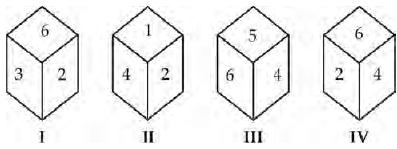
Consider the following statements.
- Figures II and III are sufficient to known as to which face is opposite to the face numbered 6.
- figures II and III are sufficient to known as to which face is opposite to the face numbered 4. .
- Figures I and IV are sufficient to known as to which face is opposite to the face numbered 3.
Which of the statements given above are correct? [2006]
(a) 1 and 3 only
(b) 1 and 2 only
(c) 2 and 3 only
(d) 1, 2 and 3
Correct Answer is Option (d).
Statement 1 is correct as it clearly shows that 1, 2, 5 and 6 are on the sides of 4 and 1 is opposite. Statement 2 is correct on the same lines. 3 is opposite 4. 3 is correct as I & IV clearly tells that 4 is opposite 3. All the three statements regarding the figure given in the question are correct. Hence, the answer is (d).
Question 20: In an office, the number of persons who take tea is twice the number of persons who take only coffee. The number of persons who take coffee is twice the number of persons who take only tea.
Consider the following statement:
- The sum of the number of persons who take either tea or coffee or both is four times the number of persons who take both coffee and tea.
- The sum of the number of persons who take only coffee and those who take only tea is twice the number of persons who take both tea and coffee.
Which of the statement(s) given above is/are correct? [2006]
(a) 1 only
(b) 2 only
(c) Both 1 and 2
(d) Neither 1 nor 2
Correct Answer is Option (b).
Let the no. of only tea takers be x, number of only coffee takers be y and number of both tea and coffee takers be z.
Now, x + z = 2y ....(i)
y + z = 2x ....(ii)
Solving (i) and (ii), we get,
x = y = z ∴ x + y + z = z + z + z = 3z
Thus, statement 1 is not correct.
Also, x + y = z + z = 2z
Thus, statement 2 is correct.
Question 21: A box contains five sets of balls while there are 3 balls in each set. Each set of balls has one color which is different from every other set, what is the least number of balls that must be removed from the box in order to claim with certainty that a pair of balls of the same colour has been removed? [2006]
(a) 6
(b) 7
(c) 8
(d) 9
Correct Answer is Option (a).
Now, any further removal of balls from any set will ensure that removed ball is of the same colour as one of the already removed balls, thus constituting a pair of the removed balls of the same colour.
Hence, minimum no. of removed balls = 6
Question 22: P, Q, R, S and T reside in a five-storeyed (Ground + 4) building, and each of them resides on a separate floor. [2006]
Further:
- T does not reside on the topmost floor.
- Q does not reside on the ground floor.
- S resides on one storey above that of P and one storey below that of R. To know as the which one of the five persons resides on the ground floor which of the above statements are sufficient/ insufficient?
(a) 1 and 3 are sufficient
(b) 2 and 3 are sufficient
(c) 1, 2 and 3 are sufficient
(d) 1, 2 and 3 are insufficient
Correct Answer is Option (d).
On the basis of the given statements there can be 3 arrangements :
As either of T or P can reside on the ground floor, so to exactly find who resides on the ground floor, given statements are insufficient.
Question 23: An equilateral triangular plate is to be cut into n number of identical small equilateral triangular plates. Which of the following can be possible value of n? [2005]
(a) 196
(b) 216
(c) 256
(d) 296
Correct Answer is Option (c).
An equilateral triangle whenever divided into equal parts, gives rise to 4 equilateral triangles. Hence, it is always in powers of 4, whenever it is equally divided further. Thus 44 = 256
Question 24: DIRECTIONS: Based on the information given below, answer the four items which follow it:
Gopal, Harsh, Inder, Jai and Krishnan have Ahmedabad, Bhopal, Cuttack, Delhi and Ernakulam as their hometowns (not necessarily in that order). They are studying in Engineering, Medical, Commerce, Economics and History college. (not necessarily in that order). None of the five boys is studying in his hometown, but each of them studies in one of the cities given above.
Further, it is given that [ 2005]
(i) Gopal’s home town is Ernakulam.
(ii) Harsh is not studying in Ahmedabad or Bhopal
(iii) Economics college is in the Bhopal
(iv) Inder ’s hometown is in Cuttack
(v) Krishnan is studying in Delhi
(vi) Jai is studying in Ernakulam and the History college is in his hometown Ahmedabad
(vii) Engineering college is situated in Ernakulam.
If Inder studies in Ahmedabad, then which one of the following is the correct combination of person Home town Place of study? [2005]
(a) Gopal – Ernakulam – Delhi
(b) Jai – Ahmedabad – Ernakulam
(c) Krishnan – Delhi – Emakulam
(d) Harsh – Bhopal – Delhi
Correct Answer is Option (b).
The given information can be tabulated as follows :
Question 25: DIRECTIONS: Based on the information given below, answer the four items which follow it:
Gopal, Harsh, Inder, Jai and Krishnan have Ahmedabad, Bhopal, Cuttack, Delhi and Ernakulam as their hometowns (not necessarily in that order). They are studying in Engineering, Medical, Commerce, Economics and History college. (not necessarily in that order). None of the five boys is studying in his hometown, but each of them studies in one of the cities given above.
Further, it is given that [ 2005]
(i) Gopal’s home town is Ernakulam.
(ii) Harsh is not studying in Ahmedabad or Bhopal
(iii) Economics college is in the Bhopal
(iv) Inder ’s hometown is in Cuttack
(v) Krishnan is studying in Delhi
(vi) Jai is studying in Ernakulam and the History college is in his hometown Ahmedabad
(vii) Engineering college is situated in Ernakulam.
Who studies in Bhopal? [2005]
(a) Gopal
(b) Harsh
(c) Gopal or Inder
(d) Inder or Harsh
Correct Answer is Option (c).
The given information can be tabulated as follows :
Question 26: DIRECTIONS: Based on the information given below, answer the four items which follow it:
Gopal, Harsh, Inder, Jai and Krishnan have Ahmedabad, Bhopal, Cuttack, Delhi and Ernakulam as their hometowns (not necessarily in that order). They are studying in Engineering, Medical, Commerce, Economics and History college. (not necessarily in that order). None of the five boys is studying in his hometown, but each of them studies in one of the cities given above.
Further, it is given that [ 2005]
(i) Gopal’s home town is Ernakulam.
(ii) Harsh is not studying in Ahmedabad or Bhopal
(iii) Economics college is in the Bhopal
(iv) Inder ’s hometown is in Cuttack
(v) Krishnan is studying in Delhi
(vi) Jai is studying in Ernakulam and the History college is in his hometown Ahmedabad
(vii) Engineering college is situated in Ernakulam.
Which college is situated in Inder's hometown? [2005]
(a) Commerce
(b) Medical
(c) Economics
(d) Commerce or Medical
Correct Answer is Option (d).
The given information can be tabulated as follows :
Question 27: DIRECTIONS: Based on the information given below, answer the four items which follow it:
Gopal, Harsh, Inder, Jai and Krishnan have Ahmedabad, Bhopal, Cuttack, Delhi and Ernakulam as their hometowns (not necessarily in that order). They are studying in Engineering, Medical, Commerce, Economics and History college. (not necessarily in that order). None of the five boys is studying in his hometown, but each of them studies in one of the cities given above.
Further, it is given that [ 2005]
(i) Gopal’s home town is Ernakulam.
(ii) Harsh is not studying in Ahmedabad or Bhopal
(iii) Economics college is in the Bhopal
(iv) Inder ’s hometown is in Cuttack
(v) Krishnan is studying in Delhi
(vi) Jai is studying in Ernakulam and the History college is in his hometown Ahmedabad
(vii) Engineering college is situated in Ernakulam.
Which is Krishnan's hometown? [2005]
(a) Ahmedabad
(b) Cuttack
(c) Bhopal
(d) Cannot be determined.
Correct Answer is Option (c).
The given information can be tabulated as follows :
Question 28: A person stands at the middle point of a wooden ladder, which starts slipping between a vertical wall and the floor of a room. The path traced by a person standing at the middle point of the slipping ladder, is [2004]
(a) a straight line
(b) an elliptical path
(c) a circular path
(d) a parabolic path
Correct Answer is Option (c).
Question 29: DIRECTIONS: The details given below relate to the FOUR items that follow:
Amit wishes to buy a magazine, four magazines one each on politics, sports, science and films are available to choose from. They are edited by Feroz, Gurbaksh, Swami and Ila (not necessarily in that order) and published by Aryan, Bharat, Charan and Dev Publishers (not necessarily in that order) Further, it is given that
(i) Dev publishers have published the magazine edited by Feroz.
(ii) The magazine on politics is published by Aryan Publishers
(iii) The magazine, on films is edited by Swami and is not published by Charan Publishers
(iv) The magazine on science is edited by Ila.
For the following four items, select the correct answer.
The magazine on science is published by [2004]
(a) Aryan Publishers
(b) Bharat Publishers
(c) Charan Publishers
(d) Dev Publishers
Correct Answer is Option (c).
Since, magazines on films is not published by Charan publishers, so it must be published by the remaining publisher, i.e., Bharat publisher. Hence, Charan publisher is left with only one option, i.e. magazine on Science. Only editor left out is Gurubaksh, so it must be placed for the politics’s magazine. Also, only magazine left out is Sports. So it should be put for Dev publisher.
Final arrangement :
Question 30: DIRECTIONS: The details given below relate to the FOUR items that follow:
Amit wishes to buy a magazine, four magazines one each on politics, sports, science and films are available to choose from. They are edited by Feroz, Gurbaksh, Swami and Ila (not necessarily in that order) and published by Aryan, Bharat, Charan and Dev Publishers (not necessarily in that order) Further, it is given that
(i) Dev publishers have published the magazine edited by Feroz.
(ii) The magazine on politics is published by Aryan Publishers
(iii) The magazine, on films is edited by Swami and is not published by Charan Publishers
(iv) The magazine on science is edited by Ila.
For the following four items, select the correct answer.
The magazine on sports is [2004]
(a) edited by Feroz
(b) edited by Gurbaksh
(c) published by Bharat Publishers
(d) published by Charan Publishers
Correct Answer is Option (a).
Since, magazines on films is not published by Charan publishers, so it must be published by the remaining publisher, i.e., Bharat publisher. Hence, Charan publisher is left with only one option, i.e. magazine on Science. Only editor left out is Gurubaksh, so it must be placed for the politics’s magazine. Also, only magazine left out is Sports. So it should be put for Dev publisher.
Final arrangement :